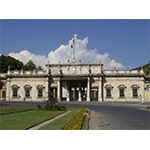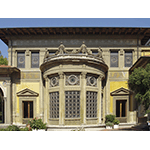Thermal Baths of Montecatini
Already in the early 15th century Ugolino da Montecatini, in his Tractatus de Balneis, prescribed rules for thermal treatments: the water of the "Bagno Nuovo", later known as the Tettuccio, "admirably releases the stomach and provokes vomiting; opens obstructions, especially those of the kidneys and occasionally dissolves kidney stones. Kills and expels worms; stimulates the appetite. It should be drunk in the morning for three consecutive days. The cure must be continued until the water expulsed is as limpid as when it was ingested. A great number of men and women, for the most part peasants or artisans from Pistoia, Prato and even Florence, visit these thermal baths without following any rules. I have seen some of them drink as much as a barrel of this water and then expel it crystal clear".
In 1430 the building of a fishing-weir in the nearby Padule di Fucecchio, at the order of the Republic of Florence, caused problems for the drainage of water from the Baths. This was the beginning of a long period of decline, despite the fact that the waters of Montecatini were recommended by illustrious scientists such as Gabriele Falloppia, Andrea Bacci, Andrea Cesalpino, Pompeo della Barba, Francesco Redi and others. Redi recommended the waters as a remedy for dysentery and colic.
Finally, in the second half of the 18th century, Grand Duke Peter Leopold of Lorraine had the fishing-weir demolished and the Baths rebuilt, inaugurating a felicitous season for thermal cures. In 1788 Alessandro Bicchierai published a treatise (Dei Bagni di Montecatini) [Concerning the Baths of Montecatini] in which he went beyond the purely descriptive tradition to present new methods of analysis that established the nature and properties of the waters.
In the 19th century Montecatini and other important thermal stations in Tuscany, such as Bagni di Pisa and Bagni di Lucca, attained a peak of splendour, becoming places frequented by famous Italian and European celebrities. In August 1918 Maria Sklodowska-Curie, the illustrious Polish scientist, in collaboration with the chemists Camillo Porlezza and Raffaello Nasini, measured the radioactivity of the thermal waters at the Tettuccio establishment.
Visited by artists throughout the 20th century, Montecatini is a masterpiece of garden-city of the arts. With its elegant thermal establishments, it is one of the best-known spas in Europe.
****************************
Texts by Graziano Magrini
English translation by Catherine Frost
Last update 08/feb/2008





